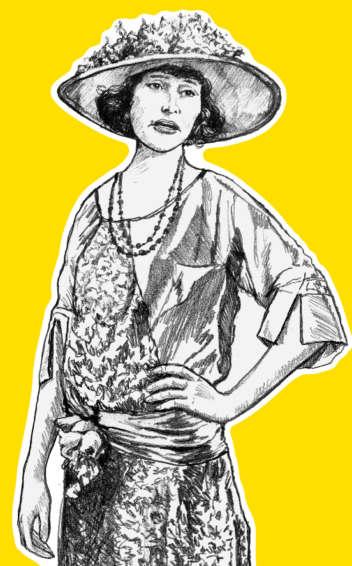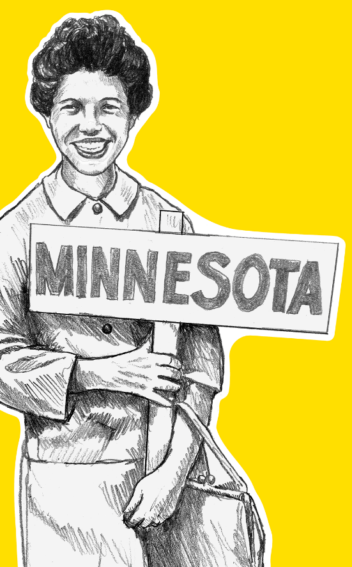August 26, 2020 marks the 100th anniversary of the official adoption of the 19th Amendment – “The right of citizens of the United States to vote shall not be denied or abridged by the United States or by any State on account of sex.” But not all women were afforded nor could exercise their right to vote as part of this landmark U.S. Constitutional Amendment. Many Native American women could not vote until they achieved citizenship in 1924. And many people of color were unable to exercise their right to vote until the Voting Rights Act of 1965.
Many Minnesota women were on the front lines of securing “Votes For Women.” However, the suffrage story has most often been told through the lens of the white women who led the way on this long journey to expand voting rights. There were however many women of color who were also leaders in the struggle to overturn barriers to voting rights – barriers that persist to this day. Let’s meet five great women who made a difference!
Marie Bottineau Baldwin
1863-1952
The trouble in this Indian question which I meet again and again is that it is not the Indian who needs to be educated so constantly up to the white man, but that the white man needs to be educated to the Indian.
– Marie Bottineau Baldwin, quoted in “Indian Women the First Suffragists and Used Recall, Chippewa Avers,” Washington Times, August 3, 1914
 Marie Bottineau Baldwin was born in Pembina, a town on her ancestral homelands on the current North Dakota-Minnesota border. A member of the Turtle Mountain Band of Chippewa Indians, Baldwin attended school in the Twin Cities. She worked as a clerk in the Minneapolis firm established by her father, a lawyer who practiced on behalf of Ojibwe people.
Marie Bottineau Baldwin was born in Pembina, a town on her ancestral homelands on the current North Dakota-Minnesota border. A member of the Turtle Mountain Band of Chippewa Indians, Baldwin attended school in the Twin Cities. She worked as a clerk in the Minneapolis firm established by her father, a lawyer who practiced on behalf of Ojibwe people.
In the early 1890s, she moved to Washington, DC, to fight for treaty rights for Native Americans. President Theodore Roosevelt appointed her a clerk in the Office of Indian Affairs. When Baldwin earned a degree from Washington College of Law in 1912, she was the school’s first woman of color and indigenous woman graduate. She helped establish national alliances and networks of Native people as an officer in the Society of American Indians.
Baldwin was also a suffrage organizer and marched with other lawyers in the 1913 march in Washington, DC. She was among the group of suffrage leaders who met with President Woodrow Wilson to enlist his support. Baldwin’s life work demonstrates the multifaceted concerns of Native women. As they sought ways to support their communities, treaty rights and tribal sovereignty often edged out suffrage.
Nellie Griswold Francis
1874-1969
Your children will reap the harvest of our solidarity — of our determination to stand together, to fight together, and, if needs be, to die together.
— Nellie Griswold Francis, from a speech published in The Appeal, May 7, 1921
 Nellie Griswold Francis founded the Everywoman Suffrage Club (ESC) in 1914. It was the only Black suffrage organization in Minnesota.
Nellie Griswold Francis founded the Everywoman Suffrage Club (ESC) in 1914. It was the only Black suffrage organization in Minnesota.
Francis knew that voting was just one of many civil rights denied her community. Her reach was nationwide. She chaired the Press Department of the National Association of Colored Women’s Clubs, and was active in the NAACP and the Urban League. Booker T. Washington, Ida B. Wells, and other civic leaders were her friends and supporters.
Francis and other ESC members attended the Minnesota Woman Suffrage Association convention in 1916. She believed in working with white suffrage organizations, and she enlisted white women to the cause of Black women’s suffrage.
This was a controversial stance that cost Francis allies. The national suffrage movement was segregated, often as a tactical move by white leadership. Racist statements and actions were commonplace. But Francis followed the path of her aunt Juno Frankie Pierce, a Nashville suffragist who employed similar techniques.
In 1920, the ESC became the Everywoman Progressive Council, dedicated to “the promotion of political and economic equality and social justice of the Negro, cooperation between white and colored women and men, training of local colored women leaders, and fostering the recognition of Negroes who have achieved success.”
 Isabelle Bellecourt
Isabelle Bellecourt
1858-1936
Isabelle Bellecourt was a citizen of the White Earth Nation and lived on the White Earth Reservation. Her husband, Eustace, fought in the Civil War and her sons Charles (Marine Corps) and Paul (Cavalry) fought in World War I.
She was proud of her son’s military service, and expressed this in a letter to the White Earth newspaper, The Tomahawk, in 1918 with her sons deployed to France: “I rest in peace for I know my sons are doing what is right and what their father would have them do.” Bellecourt celebrated her family’s contribution by serving on the Armistice Day celebration committee at White Earth in 1923.
Bellecourt’s involvement in both her Native nation and in the U.S. war effort was common during World War I. At the time, Native American men who were U.S. citizens could volunteer or be drafted into military service, and many served. However, citizenship status for Native Americans was often unclear, leading the draft boards to sometimes assign citizenship status — and thus draft eligibility — arbitrarily. At times, this barred Native Americans who vol-unteered to serve, while others were allowed to volunteer despite lack of U.S. citizenship.
Ruth Tanbara
1907-2008
Everything was trial and error and the villain was race prejudice, fear, war hysteria, intolerance, and discrimination.
— Ruth Tanbara, from “The Evacuation Experience,” in Reflections: Memoirs of Japanese American Women in Minnesota, 1995
 In 1942, Ruth Tanbara and her husband Earl were the first Japanese Americans to resettle in St. Paul as a result of President Roosevelet’s Executive Order 9066. The Order authorized the forced removal of residents of Japanese descent from their homes all along the West Coast, regardless of their citizenship status.
In 1942, Ruth Tanbara and her husband Earl were the first Japanese Americans to resettle in St. Paul as a result of President Roosevelet’s Executive Order 9066. The Order authorized the forced removal of residents of Japanese descent from their homes all along the West Coast, regardless of their citizenship status.
Anti-Japanese discrimination in Minnesota was prevalent, fueled by the on-going war. After a neighbor reported Tanbara to the FBI suspecting that she was entertaining Japanese soldiers, she hung a service flag in her window. The soldiers Tanbara hosted were her brother Howard and his Army friends, who were training at the Military Intelligence Service Language School at Fort Snelling.
Tanbara became a leader in the local Japanese community. She served on the boards of the YWCA and the International Institute, among other organizations. Through these positions, she built trust among white neighbors and assisted new residents with finding housing, work, and gaining citizenship.
Until 1952, U.S. law barred Issei, Japanese immigrants, from becoming citizens, thereby excluding them from the right to vote. This policy extended to many people of Asian descent, and had lasting generational effects. Through her lifelong dedication to community service, Ruth Tanbara helped immigrants, from Japan and elsewhere, become engaged citizens.
Josie Johnson
b. 1930
I have concluded that although the struggle takes on different forms and requires different strategies, the basic struggle is the same.
— Josie Johnson, Hope in the Struggle, 2019
 Dr. Josie Johnson continues to fight for and protect voting rights for Black Minnesotans. She often speaks of her efforts as building upon her ancestors’ struggles for freedom and civil rights. In Minneapolis, she worked as a community organizer for the Urban League and was active in the League of Women Voters, eventually becoming the first Black national board member.
Dr. Josie Johnson continues to fight for and protect voting rights for Black Minnesotans. She often speaks of her efforts as building upon her ancestors’ struggles for freedom and civil rights. In Minneapolis, she worked as a community organizer for the Urban League and was active in the League of Women Voters, eventually becoming the first Black national board member.
In the national movement for civil rights, Dr. Johnson participated in the official Minnesota delegation at the March on Washington. As a part of the Wednesdays in Mississippi movement, she traveled to Mississippi to covertly support efforts for racial justice, despite the possibility of retaliation from the Ku Klux Klan.
As a lobbyist, Dr. Johnson supported a fair housing bill by gathering evidence of housing discrimination affecting Black Minnesotans. She was also an integral part of the effort to pass the bill that established the Fair Employment Practices Commission.
Dr. Johnson has always prioritized education. She founded the Junior Service League, a mentoring program that connected Black girls in junior high with professional Black women. At the University of Minnesota, she was the first Black woman on the Board of Regents and worked to create the African American Studies Program.
Remarkable women fought for voting rights for all. We are learning more about them every day. Inspired by their stories, what actions will YOU take to shape our democracy?
Illustrations by Mathew Lefebvre, courtesy of the Minnesota Historical Society.






